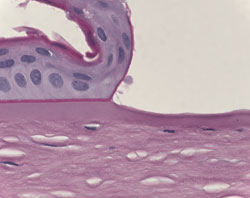Epikeratome system provides consistency, good results
The CooperVision EpiVision device has a good safety profile and is designed to create flaps reproducibly, users say.
Click Here to Manage Email Alerts
The EpiVision epikeratome, distributed by CooperVision Surgical, is an accurate, safe instrument for performing epi-LASIK, according to surgeons who have used the device.
“I performed the first case in the United States once it received approval,” Terrence P. O’Brien, MD, said in an interview with Ocular Surgery News. “I knew that, compared to some other devices, this had a good track record for making a reliable flap that was reproducible, and the safety track record was great.”
In interviews with Ocular Surgery News, Dr. O’Brien and other EpiVision users offered tips for surgeons wishing to adopt epi-LASIK with the EpiVision system.
Safety and accuracy
“The device has a good safety profile, in that it does not extend into the stroma as some of the other epithelial separators have been reported to do,” Dr. O’Brien said.
|
Image: CooperVision |
The company attributes the safety of its device to the applanation system that flattens the cornea before separating the tissues, creating a near-parallel plane of separation. This eliminates variables such as corneal steepness and cleaves the tissue without putting significant pressure on Bowman’s layer or the stroma, allowing safer and more easily replicated sheets, according to information supplied by CooperVision.
Bruce L. Larson, MD, said the EpiVision system requires minimal suction time. This means the patient’s IOP is elevated for the least amount of time, he said.
Dr. Larson said that the suction is dramatically improved with the newest ring for the EpiVision, the Hi-Vac 19-mm ring. The Hi-Vac should be available commercially in May, according to CooperVision.
The EpiVision needs only 20 seconds of vacuum, Dr. Larson said, adding that because he releases the suction on the back-pass, he uses it for only about 12 seconds or less.
Another user, Shachar Tauber, MD, said the EpiVision’s best feature is the quality of the epithelial flap, which he said is uniform, with no incursions into Bowman’s membrane.
Dr. Larson agreed. “It just does perfect flap after perfect flap after perfect flap,” Dr. Larson said. “The creation of the epithelial flap is sort of a done deal. … That lets me worry about other issues.”
Dr. Larson said he can consistently make 9 mm flaps. Dr. O’Brien said he likes to adjust the size of the flaps while maintaining the ability to reproduce them.
“Of the devices I’ve tried, this tends to make the best flap in terms of the dimensions, the diameter and the reproducibility,” Dr. O’Brien said.
Changing over
Dr. Tauber said that epi-LASIK with the EpiVision device is becoming “the treatment of choice” for many surgeons who perform surface ablation. He said half of his refractive practice is surface ablation, a significant increase within the past year.
Dr. O’Brien said epi-LASIK is now a third of his refractive practice, compared to 5% previously.
“It hasn’t replaced LASIK. However, there has been a steady increase in the percentage of patients for whom we’ll use this method,” he said.
For a surgeon considering adopting epi-LASIK, Dr. O’Brien recommended trying all of the available units. “I think they’ll be impressed with the engineering and design and the reproducibility of flap creation” with the EpiVision, he said.
Dr. Larson said if a surgeon is transitioning from traditional PRK or LASIK to epi-LASIK, “all the surgeon needs to understand is that there is a definite learning curve that they need to get through. Epi-LASIK is a different animal.”
However, he said, surgeons who have previously performed laser epithelial keratomileusis (LASEK) should experience no difficulty with the transition to epi-LASIK.
All three surgeons said CooperVision technicians and other physicians with experience using the EpiVision were helpful in training and supplying information during their transition periods.
“It will be an excellent procedure, but it does take a little bit of time, and certainly the office staff will need to be trained” to manage the longer recovery time compared to LASIK, Dr. Larson added.
Dr. Larson said a possible detraction for LASEK surgeons is increased cost, including the equipment and separators, which are renewed for each patient. He said he feels that epi-LASIK and the EpiVision are the best choice.
“The EpiVision’s worked quite well,” Dr. Tauber agreed. “It really meets all of our needs.”
For more information:
- Terrence P. O’Brien, MD, can be reached at Bascom Palmer Eye Institute, 7108 Fairway Drive, Palm Beach Gardens, FL 33418; 561- 515-1544; fax: 561-515-1588; e-mail: tobrien@med.miami.edu.
- Schachar Tauber, MD, can be reached at St. John’s Clinic, Eye Specialists, 1229 E. Seminole, Suite 430, Springfield, MO 65807; 417-820-9723; 417-820-9725; e-mail: stauber@sprg.mercy.net.
- Bruce L. Larson, MD, can be reached at Larson Eye Center, 126 West First St., Hinsdale, IL 60521; 630-325-5200; fax: 630- 325-5569; e-mail: bclmd293@aol.com. Dr. Larson has no direct financial interest in the products mentioned in this article, nor is he a paid consultant for any companies mentioned.
- CooperVision, maker of EpiVision, can be reached at 370 Woodcliff Drive, Suite 200 Fairport, NY 14450; Web site: www.coopervision.com.
- Katrina Altersitz is an OSN Staff Writer who covers all aspects of ophthalmology.

